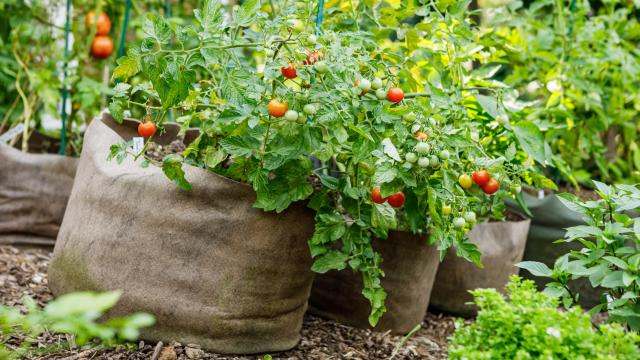If you live in a small space or are just a bit of a lazy gardener, grow bags might be the solution for your garden this summer. They’re inexpensive, light-weight, and easy to move around, plus they make great environments for a variety of flowers, vegetables, and herbs. Even if you’re stuck in a little apartment with only a fire escape as your link to the outdoors, you can grow potatoes, cilantro, and even tomatoes to munch on all summer.
What to know about grow bags
The bags come in a variety of sizes but are inexpensive, with five costing about $20. They fold up when they’re not in use, making them easier to store in the winter than pots; and in use, they’re lighter, too, so you can move them around as needed — but they’re not set-it-and-forget-it. You do need to fertilize them more often than you would plants in the ground.
Stick with plants that have shallow root systems and don’t bother planting anything that sprawls out too much, like pumpkins. The roots will really love the porous sides of the bags, which let in more air than a traditional pot would and enable them to spread out more, rather than growing downward in a spiral. Plus, it’s damn hard to overwater them, as any excess water just comes out the sides — you just may have to water more than usual if too much seeps out. And don’t use any filler to save space in the bag like you might with a pot; your plants will need all the soil they can get.
The size of bag you use is of the utmost importance here, though, so let’s review which plants go in which bags.
Bag sizing
Overall, you want to look for “dwarf,” “bush,” or “compact” plant varieties when selecting which plants to grow in a bag, according to Growing in the Garden, but picking the right size of bag for each plant is key, as well.
An extra-small grow bag, which holds up to two gallons of soil, is great for herbs and other small veggies, including:
- Sage
- Rosemary
- Thyme
- Kale or lettuce
- Green onions
- Basil
- Radishes
- Chard
- Arugula
A small grow bag, which holds up to three gallons of soil, can be used for slightly larger veggies, such as:
- Carrots
- Beets
- Strawberries
- Celery
- Dill, cilantro, and parsley
Medium grow bags, which hold up to five gallons of soil, will support even bigger veggies, like these:
- Beans
- Broccoli
- Cabbage
- Okra
- Potatoes
- Cucumbers
- Eggplant
- Peppers
- Ginger
Large grow bags, which hold up to 10 gallons of soil, are the ones you call in for the big guys: Sweet potatoes and tomatoes.

Leave a Reply
You must be logged in to post a comment.